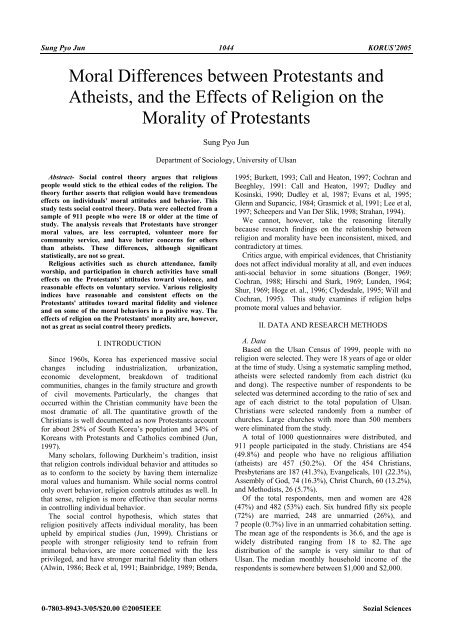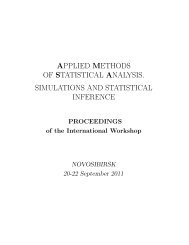You also want an ePaper? Increase the reach of your titles
YUMPU automatically turns print PDFs into web optimized ePapers that Google loves.
Sung Pyo Jun 1044<br />
KORUS’2005<br />
Moral Differences between Protestants and<br />
Atheists, and the Effects of Religion on the<br />
Morality of Protestants<br />
Abstract- Social control theory argues that religious<br />
people would stick to the ethical codes of the religion. The<br />
theory further asserts that religion would have tremendous<br />
effects on individuals' <strong>moral</strong> attitudes and behavior. This<br />
study tests social control theory. Data were collected from a<br />
sample of 911 people who were 18 or older at the time of<br />
study. The analysis reveals that Protestants have stronger<br />
<strong>moral</strong> values, are less corrupted, volunteer more for<br />
community service, and have better concerns for others<br />
than atheists. These <strong>differences</strong>, although significant<br />
statistically, are not so great.<br />
Religious activities such as church attendance, family<br />
worship, and participation in church activities have small<br />
effects on the Protestants' attitudes toward violence, and<br />
reasonable effects on voluntary service. Various religiosity<br />
indices have reasonable and consistent effects on the<br />
Protestants' attitudes toward marital fidelity and violence<br />
and on some of the <strong>moral</strong> behaviors in a positive way. The<br />
effects of religion on the Protestants' <strong>moral</strong>ity are, however,<br />
not as great as social control theory predicts.<br />
I. INTRODUCTION<br />
Since 1960s, Korea has experienced massive social<br />
changes including industrialization, urbanization,<br />
economic development, breakdown of traditional<br />
communities, changes in the family structure and growth<br />
of civil movements. Particularly, the changes that<br />
occurred within the Christian community have been the<br />
most dramatic of all. The quantitative growth of the<br />
Christians is well documented as now Protestants account<br />
for about 28% of South Korea’s population and 34% of<br />
Koreans with Protestants and Catholics combined (Jun,<br />
1997).<br />
Many scholars, following Durkheim’s tradition, insist<br />
that religion controls individual behavior and attitudes so<br />
as to conform to the society by having them internalize<br />
<strong>moral</strong> values and humanism. While social norms control<br />
only overt behavior, religion controls attitudes as well. In<br />
that sense, religion is more effective than secular norms<br />
in controlling individual behavior.<br />
The social control hypothesis, which states that<br />
religion positively affects individual <strong>moral</strong>ity, has been<br />
upheld by empirical studies (Jun, 1999). Christians or<br />
people with stronger religiosity tend to refrain from<br />
im<strong>moral</strong> behaviors, are more concerned with the less<br />
privileged, and have stronger marital fidelity than others<br />
(Alwin, 1986; Beck et al, 1991; Bainbridge, 1989; Benda,<br />
Sung Pyo Jun<br />
Department of Sociology, University of Ulsan<br />
1995; Burkett, 1993; Call and Heaton, 1997; Cochran and<br />
Beeghley, 1991: Call and Heaton, 1997; Dudley and<br />
Kosinski, 1990; Dudley et al, 1987; Evans et al, 1995;<br />
Glenn and Supancic, 1984; Grasmick et al, 1991; Lee et al,<br />
1997; Scheepers and Van Der Slik, 1998; Strahan, 1994).<br />
We cannot, however, take the reasoning literally<br />
because research findings on the relationship between<br />
religion and <strong>moral</strong>ity have been inconsistent, mixed, and<br />
contradictory at times.<br />
Critics argue, with empirical evidences, that Christianity<br />
does not affect individual <strong>moral</strong>ity at all, and even induces<br />
anti-social behavior in some situations (Bonger, 1969;<br />
Cochran, 1988; Hirschi and Stark, 1969; Lunden, 1964;<br />
Shur, 1969; Hoge et. al., 1996; Clydesdale, 1995; Will and<br />
Cochran, 1995). This study examines if religion helps<br />
promote <strong>moral</strong> values and behavior.<br />
II. DATA AND RESEARCH METHODS<br />
A. Data<br />
Based on the Ulsan Census of 1999, people with no<br />
religion were selected. They were 18 years of age or older<br />
at the time of study. Using a systematic sampling method,<br />
atheists were selected randomly from each district (ku<br />
and dong). The respective number of respondents to be<br />
selected was determined according to the ratio of sex and<br />
age of each district to the total population of Ulsan.<br />
Christians were selected randomly from a number of<br />
churches. Large churches with more than 500 members<br />
were eliminated from the study.<br />
A total of 1000 questionnaires were distributed, and<br />
911 people participated in the study. Christians are 454<br />
(49.8%) and people who have no religious affiliation<br />
(atheists) are 457 (50.2%). Of the 454 Christians,<br />
Presbyterians are 187 (41.3%), Evangelicals, 101 (22.3%),<br />
Assembly of God, 74 (16.3%), Christ Church, 60 (13.2%),<br />
and Methodists, 26 (5.7%).<br />
Of the total respondents, men and women are 428<br />
(47%) and 482 (53%) each. Six hundred fifty six people<br />
(72%) are married, 248 are unmarried (26%), and<br />
7 people (0.7%) live in an unmarried cohabitation setting.<br />
The mean age of the respondents is 36.6, and the age is<br />
widely distributed ranging from 18 to 82. The age<br />
distribution of the sample is very similar to that of<br />
Ulsan. The median monthly household income of the<br />
respondents is somewhere between $1,000 and $2,000.<br />
0-7803-8943-3/05/$20.00 ©2005IEEE Sozial Sciences
KORUS’2005 1045<br />
Sung Pyo Jun<br />
B. Variables<br />
Religious variables are frequency of religious<br />
conversations at home, frequency of family worship,<br />
subjective meaning of family worship, years of church<br />
attendance, position at the church, and participation in<br />
church activities.<br />
Religiosity consists of two variables: 1) orthodox<br />
beliefs (ie,, “God really exists”, “There is a life after<br />
death”, “There exists Satan”), and 2) personal religious<br />
experiences (ie, “I heard God’s voice”, “God responded<br />
to my prayers” etc).<br />
Morality is twofold – attitudes and behavior.<br />
To measure respondents’ attitudes, 16 statements<br />
were provided, and their responses to the 5 scale-answers<br />
were recorded. To measure purpose-oriented attitudes,<br />
the following statements were provided: “If there is<br />
no garbage can around, I have to litter”, “Even if my<br />
son is healthy, I would not send him to military<br />
service”, “Money itself is important, not the way how<br />
to make it”, “I would willingly cheat to get admitted t<br />
o a better college”, “I would even steal money for my<br />
own gain”.<br />
Sexual <strong>moral</strong>ity (marital fidelity) was measured by<br />
such statements as “Even if I’m married, I would still<br />
need a boyfriend or a mistress”, “When traveling alone, if<br />
I happen to meet a nice-looking man/woman, I wouldn’t<br />
mind having a lunch with him/her”.<br />
To measure an individuals’ <strong>moral</strong> behavior, we<br />
measured their altruistic behaviors and deviant behaviors.<br />
After several rounds of factor analysis, 5 factors were<br />
extracted: 1) material corruption (ie, stealing money, robbery),<br />
2) strong public manners (ie, littering, urinating on the street),<br />
3) weak altruism (ie, being nice to others, showing the way to<br />
a stranger), 4) strong altruism (ie, voluntary activities, helping<br />
the poor), and 5) weak public manners (ie, using a cellphone<br />
in public places, misdemeanor)<br />
III. RESULTS<br />
A. Morality of Protestants and Atheists: Attitudes and<br />
Behavior<br />
Protestants are found to be more <strong>moral</strong>istic than<br />
atheists in both attitudes and behavior (TABLE 1). And<br />
these <strong>differences</strong> are all significant statistically at the<br />
level of 0.05.<br />
Protestants have weaker purpose-oriented attitudes,<br />
sounder sexual values (marital fidelity), and less likely to<br />
rely on violence to solve a problem than atheists.<br />
In terms of behavior, Protestants tend to be less<br />
materially corrupted, more likely to conform to the public<br />
norms, and have more concerns for the less privileged<br />
than atheists<br />
Although Protestants have stronger <strong>moral</strong> values and<br />
behaviors, the <strong>differences</strong> between the two groups are not<br />
as great as one may expect.<br />
Purposeoriented<br />
attitude<br />
marital<br />
fidelity<br />
attitude<br />
toward<br />
violence<br />
material<br />
corruption<br />
strong<br />
public<br />
manners<br />
weak<br />
altruism<br />
strong<br />
altruism<br />
weak<br />
public<br />
manners<br />
TABLE 1<br />
MORALITY OF PROTESTANTS AND ATHEISTS<br />
T-test<br />
items Cronbach's<br />
alpha T sig<br />
6 .7593 11.630 .000<br />
N mean<br />
Prot 446 26.1973<br />
athe 451 23.4656<br />
4 .8398 11.273 .000<br />
Prot<br />
athe<br />
443<br />
452<br />
15.9413<br />
13.3031<br />
Prot 451 6.7960<br />
2 .7120 10.324 .000 athe 455 5.4967<br />
6 .8373 2.915 .004<br />
Prot<br />
athe<br />
442<br />
452<br />
28.9977<br />
28.5575<br />
Prot 446 13.6614<br />
3 .8087 8.654 .000 athe 453 12.4812<br />
3 .7312 6.399 .000<br />
Prot<br />
athe<br />
438<br />
451<br />
12.1438<br />
11.3415<br />
4 .7054 5.173 .000<br />
Prot<br />
athe<br />
437<br />
450<br />
11.7529<br />
10.8622<br />
Prot 447 7.5973<br />
2 .5449 2.975 .003 athe 453 7.2914<br />
B. Moral Attitudes of Protestants (TABLE 2)<br />
Demographic variables, religious variables, and control<br />
variables have some influence on a Protestant's attitudes.<br />
Personal religious activities, spouse's religiosity, and<br />
utilitarian purposes for attending church influence a<br />
person's purpose-oriented attitudes<br />
TABLE 2<br />
MORAL ATTITUDES OF PROTESTANTS<br />
Dep Var<br />
Purpose-orient sexual values<br />
attit toward<br />
violence<br />
b beta B beta b beta<br />
rel conversation -.004 -.004 -.153# -.128 .094 .081<br />
church attend-yr .006 .074 -.004 -.056 .005 .064<br />
Position -.014 -.014 .029 .027 .253** .235<br />
freq-fam worship .022 .036 .004 .007 -.066 -.106<br />
mean-fam worship .029 .037 .068 .084 -.049 -.063<br />
worship attend -.067 -.062 .036 .032 .075 .069<br />
activity .053 .081 .007 .011 .073 .109<br />
rel orthodox .052 .057 .239**** .250 .072 .088<br />
life after death .069 .071 .103 .100 .066 -.070<br />
rel experience .056 .059 -.104 -.104 .093 -.137<br />
personal<br />
rel activity<br />
.221* .221 .280** .269 .102 -.014<br />
sex .016 .009 .246 .122 .449** .229<br />
age .003 .029 .012 .117 .016 .150<br />
house income -.078 -.078 -.020 -.020 .009 .010<br />
educ .110# .167 -.040 -.060 .142* .215<br />
TV -.162# -.127 .040 .031 -.032 -.025<br />
spouse <strong>moral</strong>ity .174# .134 .060 .045 -.148 -.112<br />
spouse relig -.183* -.218 .054 .062 .012 .015<br />
mom <strong>moral</strong>ity .073 .055 -.092 -.066 .000 .000<br />
mom relig .038 .064 .141* .228 -.076 -.127<br />
dad <strong>moral</strong>ity .143# .129 .054 .047 -.219* -.196<br />
dad relig -.088 -.128 -.068 -.095 .105 .151<br />
brother <strong>moral</strong>ity .050 .035 .116 .077 .121 .083<br />
brother relig -.056 -.087 -.040 -.059 .003 .005<br />
friend <strong>moral</strong>ity -.081 -.062 -.039** -.225 .045 .035<br />
friend relig .029 .044 .036 .051 .087# .127<br />
utilitarian value -.176** -.181 -.082 -.086 -.021 -.022<br />
<strong>moral</strong> value .021 .021 .201* .190 -.059 -.058<br />
Sozial Sciences
Sung Pyo Jun 1046<br />
KORUS’2005<br />
A person who frequently prays alone or loves to read<br />
religious books is less likely to do im<strong>moral</strong> things for<br />
selfish reasons. And a person who goes to church for<br />
utilitarian purposes has a stronger tendency of doing<br />
im<strong>moral</strong> things for selfish reasons than others.<br />
Orthodox beliefs, personal religious activities,<br />
mother’s religiosity have a positive effect on one’s sexual<br />
attitudes (marital fidelity), and a friend’s <strong>moral</strong>ity has a<br />
negative effect on one’s sexual attitudes.<br />
The higher is one’s position at a church and the higher<br />
is one’s educational achievement, the less likely he/she is<br />
to rely on violence as a means for solving conflict. Men<br />
are more likely to be violent than women. And a person<br />
whose father has a higher <strong>moral</strong>ity has a stronger<br />
tendency to rely on violence.<br />
Church attendance and family worship were expected<br />
to have a positive effect and TV-watching time was<br />
expected to have a negative effect on one’s attitudes. But<br />
we cannot find enough evidences to support the<br />
expectations.<br />
C. Deviant Behavior of Protestants (TABLE 3)<br />
The higher is a person’s position at the church and the<br />
more actively one does religious activities at home, the<br />
less likely is he or she to be corrupted materially. And a<br />
woman is less likely to be involved in a misdemeanor<br />
than a man.<br />
TABLE 3<br />
MORALITY OF PROTESTANTS: DEVIANT BEHAVIOR<br />
Dep Var<br />
Material Corruption misdemeanor<br />
b beta b beta<br />
rel conversation -.076 -.094 .062 .060<br />
attendance-yr -.029 -.050 -.002 -.039<br />
Position .155* .202 -.028 -.029<br />
freq-fam worship -.027 -.062 -.001 -.002<br />
mean-fam worship -.030 -.053 -.021 -.029<br />
worship part -.096 -.125 .049 .050<br />
church activity .053 .110 -.033 -.053<br />
rel orthodox .066 .104 .130# .157<br />
life after death .071 .097 .009 .010<br />
rel experience -.070 -.102 -.032 -.036<br />
rel activity .175* .250 .084 .093<br />
sex .130 .095 .526*** .297<br />
age .064 .009 .010 .109<br />
house income -.078 -.111 .060 .066<br />
Educ .018 .040 .119# .201<br />
TV -.005 -.006 -.008 -.007<br />
spouse <strong>moral</strong>ity -.087 -.095 .025 .021<br />
spouse relig .032 .006 -.091 -.119<br />
mom <strong>moral</strong>ity -.014 -.015 -.070 -.055<br />
mom relig .001 .004 .058 .105<br />
dad <strong>moral</strong>ity .065 .082 .129 .125<br />
dad relig -.005 -.011 -.076 -.118<br />
brother <strong>moral</strong>ity -.052 -.052 .185 .142<br />
brother relig .026 .057 -.064 -.107<br />
friend <strong>moral</strong>ity .164# .173 -.141 -.115<br />
friend relig -.056 -.118 .029 .048<br />
utilitarian value -.058 -.085 -.035 -.040<br />
<strong>moral</strong> value .022 .032 .094 .103<br />
member contact .085 .110 -.155# -.154<br />
free time -.070 -.105 -.101 -.115<br />
D. Altruistic Behavior of Protestants (TABLE 4)<br />
The more frequently one has a family worship service,<br />
and the more frequently one prays or read religious books<br />
at home, the more likely he or she is involved in<br />
voluntary service. The stronger are one’s orthodox beliefs<br />
and the sounder are one’s mother’s values, he or she is<br />
more likely to have concerns for others. Women tend to<br />
be more concerned with others than men.<br />
TABLE 4<br />
MORALITY OF PROTESTANTS: ALTRUISTIC BEHAVIOR<br />
DEP VAR<br />
voluntary activity concern for others donation<br />
b beta b beta b beta<br />
rel conversation -.040 -035 .039 .033 -.196* -.174<br />
attendance-yr -.003 -039 ..004 .048 .009 .118<br />
position -.047 -.044 .171# .151 -.071 -.067<br />
freq-fam<br />
worship<br />
mean-fam<br />
worship<br />
.115* .183 -.084 -.129 -.013 -.022<br />
-.081 -.101 .055 .066 .032 .041<br />
worship part .071 .066 -.003 -.003 .087 .082<br />
activity part .097 .141 -.026 -.037 .074 .111<br />
rel orthodox -.009 -.010 .161* .170 .066 .075<br />
life after death -.008 -.008 .034 .031 .021 .021<br />
rel experience .026 .027 -.066 -.065 -.052 -.055<br />
rel activity .262* .265 .055 .053 .021 .023<br />
sex .188 .097 .444* .219 -.144 -.076<br />
age .006 .064 -.006 .061 .009 .095<br />
hosue income -.003 -.004 -.134 -.128 .142# .144<br />
educ .068 .106 .076 .112 -.017 -.028<br />
TV .097 .078 .057 .044 -.121 -.098<br />
spouse <strong>moral</strong>ity .043 .034 .073 .054 .161 .127<br />
spouse relig .008 .010 .009 .011 .082 .101<br />
mom <strong>moral</strong>ity -.004 -.003 .301* .207 -.022 -.017<br />
mom relig -.054 -.091 .012 .021 -.077 -.130<br />
dad <strong>moral</strong>ity .058 .051 .088 .076 -.112 -.101<br />
dad relig .048 .068 -.078 -.106 .087 .126<br />
brother <strong>moral</strong>ity .001 .001 -.089 -.061 -.027 -.020<br />
brother relig .063 .097 .007 .011 .016 .026<br />
friend <strong>moral</strong>ity -.026 -.020 .232# .166 .025 .019<br />
friend relig .057 .085 .036 .052 .085 .129<br />
utilitarian value .070 .072 -.054 -.054 .004 .005<br />
<strong>moral</strong> value -.129 -.129 .021 .021 .043 .044<br />
member contact -.059 -.054 -.118 -.103 -.034 -.032<br />
free time -.099 -.104 -.100 -.101 .059 .063<br />
IV. CONCLUSION<br />
Protestants have sounder values, are less corrupted<br />
materially, and are more involved in voluntary service,<br />
have more concerns for others than Atheists. In that<br />
sense, Protestants can be said to be more <strong>moral</strong>istic than<br />
Atheists. But the <strong>differences</strong> between Protestants and<br />
Atheists are as large as one may expect.<br />
Sozial Sciences
KORUS’2005 1047<br />
Sung Pyo Jun<br />
REFERENCES<br />
[1] Alwin, Duane, "Religion and parental child bearing orientations:<br />
evidence of a Catholic-Protestant convergence." American<br />
Journal of Sociology 92: 412-40, 1986<br />
[2] Bainbridge, William Sims, "The religious ecology of deviance."<br />
American Sociological Review 54: 288-95, 1989<br />
[3] Beck, Scott H., Bettie S. Cole, and Judith A. Hammond (1991),<br />
"Religious heritage and premarital sex: evidence from a national<br />
sample of young adults." Journal for the Scientific Study of<br />
Religion 30: 173-80, 1991<br />
[4] Benda, Brent B. "The effect of religion on adolescent delinquency<br />
revisited." Journal of Research in Crime and Delinquency 32:<br />
446-66, 1995<br />
[5] Benda, Brent B. and Robert F. Corwyn, "Religion and delinquency:<br />
the relationship after considering family and peer influences."<br />
Journal for the Scientific Study of Religion 36 (1): 81-92, 1997<br />
[6] Bonger, W. A., Criminality and Economic Conditions.<br />
Bloomington: Indiana University Press, 1969<br />
[7] Bowman, S. Loren, Power and Polity among the Brethren: A<br />
Study of Church Governance. Elgin, Illinois: Brethren Press, 1987<br />
[8] Burkett, S. R., "Perceived parents' religiosity, friends' drinking,<br />
and hellfire: a panel study of adolescent drinking." Review of<br />
Religious Research 35: 136-54 , 1993<br />
[9] Call, Vaughn R. A. and Tim B. Heaton, "Religious influence on<br />
marital stability." Journal for the Scientific Study of Religion 36:<br />
382-92, 1997<br />
[10] Chadwick, Bruce A. and Brent L. Top, "Religiosity and<br />
delinquency among LDS adolescents." Journal for the Scientific<br />
Study of Religion 32 (1): 51-67, 1993<br />
[11] Cochran, John K. and Leonard Beeghley, "The influence of<br />
religion on attitudes toward nonmarital sexuality: a preliminary<br />
assessment of reference group theory." Journal for the Scientific<br />
Study of Religion 30: 45-62, 1991<br />
[12] Cochran, John. K., P. K. Wood, and B. J. Arneklev, "Is the<br />
religiosity-delinquency relationship spurious?: a test of arousal<br />
and social control theories." Journal of Research in Crime and<br />
Delinquency 31: 92-123, 1994<br />
[13] Cornwell, Marie, Stan L. Albrecht, Perry H. Cunningham, and<br />
Brian L. Pitcher, "The dimensions of religiosity: a conceptual<br />
model with an empirical t est." Review of Religious Research<br />
27: 226-44, 1986<br />
[14] Dudley, M. G. and F. A. Kosinski, "Religiosity and marital<br />
satisfaction: a research note." Review of Religious Research 32:<br />
78-86, 1990<br />
[15] Dudley, R. L., P. B. Mutch, and R. J. Cruise, "Religious factors and<br />
drug usage among Seventh-day Adventist youth in North America."<br />
Journal for the Scientific Study of Religion 26: 218-33, 1987<br />
[16] Durkheim, Emile, The Elementary Forms of Religious Life.<br />
Glencoe, Ill: Free Press, 1954<br />
[17] Ellifson, K. W., D. M. Peterson, C. K. Hadaway, "Religiosity and<br />
delinquency: a contextual analysis." Criminology 21: 505-27, 1983<br />
[18] Evans, T. D., F. T. Cullen, R. G. Dunaway, and V. S. Burton, Jr.,<br />
"Religion and crime reexamined: the impact of religion, secular<br />
controls, and social ecology on adult criminality." Criminology<br />
33: 195-217, 1995<br />
[20] Glenn, Norval D. and Michael Supancic, "The social and<br />
demographic correlates of divorce and separation in the United<br />
States: an update and reconsideration." Journal of Marriage and<br />
the Family 46: 563-75, 1984<br />
[21] Grasmick, H. G., R. J. Bursik, jr., J. K. Cochran, "Render unto<br />
Ceasar what is Ceasar's: religiosity and taxpayers' inclinations to<br />
cheat." Sociological Quarterly 32: 251-66, 1991<br />
[22] Hirschi, Travis and Rodney Stark, "Hellfire and delinquency."<br />
Social Problems 17: 202-213, 1969<br />
[23] Hoge, Dean R. Division in the Protestant House. Philadelphia:<br />
Westminster , 1976<br />
[24] Hoge, Dean R. and Jackson W. Carroll, "Determinants of<br />
commitment and participation in suburban Protestant churches."<br />
Journal for the Scientific Study of Religion 17(2): 107-27, 1978<br />
[25] S. Jun and G Armstrong “Status inconsistency and striving for<br />
power in a church: Is church a refuge or a stepping stone? Korea<br />
Journal of Population and Development, vol 26, number 1, Pp<br />
103-129, 1997<br />
[26] Jun, Sung Pyo and Gordon M. Armstrong, "The bases of power in<br />
churches: an analysis from a resource dependency perspective."<br />
Social Science Journal v34 #2: P 105-130, 1997<br />
[27] Jun, S. P, “Methodololigcal Problems of Social Control Theory”,<br />
2001<br />
[28] King, Morton B. and Richard A. Hunt, "Measuring the religious<br />
variable: national replication." Journal for the Scientific Study of<br />
Religion 14: 13-22, 1975<br />
[29] Lee, J. W., G. T. Rice, and V. B. Gillespie, "Family worship<br />
patterns and their correlation with adolescent behavior and<br />
beliefs." Journal for the Scientific Study of Religion 36: 372-81,<br />
1997<br />
[30] Lunden, W. A., Statistics on Delinquents and Delinquency.<br />
Springfield, L: Charles C Thomas, 1964<br />
[31] Palinkas, Lawrence A., "Social fission and cultural change in an<br />
ethnic Chinese church." Ethnic Groups 5: 255-77 , 1984<br />
[32] Strahan, B. J. (1994), Parents, Adolescents, and Religion.<br />
Corranbong, New South Wales: Avondale Academic Press<br />
[33] Van Roy, Ralph F., Frank D. Bean, and James R. Wood, "Social<br />
mobility and doctrinal orthodoxy." Journal for the Scientific Study<br />
of Religion 12(4): 427-39, 1973<br />
Sozial Sciences







